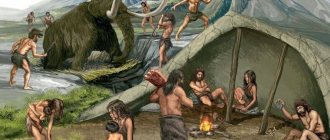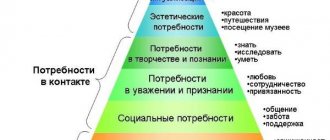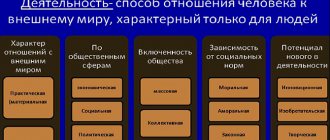Mastering the activity. Skills. Skills. Habits
Abilities, skills and habits are automated, consciously, semi-consciously and unconsciously controlled components of activity.
Skills are elements of activity that allow you to do something with high quality (for example, some kind of operation). They include automatically performed parts called skills, but in general they are consciously controlled parts of the activity.
Skills are fully automated components of skills, implemented at the level of unconscious control. A skill is an automated component of an action.
The development and improvement of activities can be represented as the transition of the components of individual skills, actions and operations to the level of skills.
Coordination of skills occurs when 1) one of the skills serves as a means of better mastering another; 2) the movement system of both skills corresponds; 3) when the end of one skill is the actual beginning of another.
Interference occurs when 1) the movement system of one skill contradicts another; 2) when moving from one skill to another, you have to break the structure of movements and relearn; 3) the system of movements of one skill is partially included in the system of movements of another, as a result of which the movement is distorted; 4) the beginning and end of both skills do not match.
Abilities, unlike skills, are formed as a result of the coordination of skills, their integration into systems using actions under conscious control.
The main quality of skills is that a person is able to change the structure of skills (skills, operations, the sequence of their implementation), while keeping the final result unchanged.
Skills and abilities are divided into types : 1) motor, 2) cognitive, 3) theoretical, 4) practical.
The third element in mastering an activity is habit . It differs from skills and abilities in that it is an unproductive element of activity, an inflexible and often unreasonable part of the activity that is performed mechanically by a person and has no conscious purpose or clearly expressed productive conclusion.
It differs from a skill in that it can be consciously controlled to a certain extent, and from a skill in that it is not always reasonable and useful.
Conclusions:
1. Behavior is the result of the activity of a living being.
2. Forms of animal behavior: instinct, learning, intellectual forms of behavior.
3. Activity is a specific type of human activity, significantly different from behavior.
4. The content of human activity is determined by the goal.
5. Main activities: play, study, work.
6. Skills are consciously controlled parts of activity. Skills are fully automated components of skills.
7. Skills can be consistent with each other, or they can interfere.
Recommended reading:
Miller, D., Galanter, Y., Pribram, K.
Plans and structure of behavior. – M., 1964.
Leontyev, A.N.
Activity.
Consciousness. Personality. // Leontyev, A.N.
Favorite
psychol. prod.: In 2 vols. – M.: Pedagogika, 1983. – T. 2. – P. 94 – 232.
Your psychologist. The work of a psychologist at school.
| Attention |
| Memory |
| Thinking |
| Imagination |
| Emotional and volitional regulation of activity |
| Variety of motives for activity |
| Modern theories of motivation |
| Stages of mastering human activity: knowledge, ability, skills, habits |
| Emotions and feelings |
| Will |
| All pages |
Page 10 of 12
3.3.4 Stages of mastering human activity: knowledge, ability, skills, habits
Automated, consciously, semiconsciously and unconsciously controlled components of activity are called skills, abilities and habits, respectively. Human knowledge about the world appears initially in the form of images, sensations and perceptions. Processing of sensory data in consciousness leads to the formation of ideas and concepts. In these two forms, knowledge is stored in memory. No matter how general the ideas and concepts are, their main purpose is the organization and regulation of practical activities. Knowledge does not exist for the sake of knowledge. They can significantly exceed the level of existing production needs, paving the way for future practical activities, reveal the possibilities of human influence on nature and society, and ultimately are always included in the regulation of activities. Knowledge and action are closely intertwined. Both the child and the adult, actions with objects simultaneously give knowledge about their properties and the possibilities of handling them. When faced with an unfamiliar object, a person strives, first of all, to gain knowledge of how to act with it, how to use it. A person receives this knowledge from specialized literature, from instructions and uses it in his activities. Knowledge raises activities to a higher level of awareness and increases a person’s confidence in the correctness of its implementation. Activity without knowledge is impossible. General characteristics of skills An indispensable component of activity is a variety of skills and abilities. Skills and abilities are characteristics of how a person performs various actions. Different opinions are expressed about their relationship. Some researchers believe that skills precede skills. Others believe that skills arise before skills, and skills are considered as steps, levels of a person’s mastery of certain actions performed on the basis of knowledge. In this case, skill is considered as the first stage of mastering any action, and skill is considered as the second stage, meaning good, completely successful, error-free execution of this action. The reason for these discrepancies is the ambiguity of the word “skill”. Skill is the most elementary level of performing actions, and a person’s mastery in this type of activity, that is, skill means that the individual has acquired the relevant knowledge and can apply it, consciously controlling his every step in accordance with this knowledge. A skill means that the application of this knowledge has become automated, that is, skills are fully automated, instinctive components of skills, implemented at the level of unconscious control. If by action we understand a part of an activity that has a clearly defined conscious goal, then a skill can also be called an automated component of an action. “Skill,” pointed out S.L. Rubinstein, - arises as a consciously automated action and then functions as an automated way of performing the action. The fact that a given action has become a skill means that the individual, as a result of the exercise, has acquired the ability to carry out this operation without making its implementation his conscious goal.” Thus, exercises are of great importance in the formation of all types of skills. Thanks to them, skills are automated, skills and activities are improved in general. Exercises are necessary both at the stage of developing skills and abilities, and in the process of maintaining them. Without constant, systematic exercise, skills and abilities are usually lost and lose their qualities. It is necessary to distinguish between elementary skills that follow knowledge and the first experience of action, and skills that express one or another degree of mastery in performing activities that arise after the development of skills. Elementary skills are actions that arise on the basis of knowledge as a result of imitation of actions or independent trial and error in handling a subject. Skill-mastery arises on the basis of already developed skills and a wide range of knowledge. General characteristics of skills An activity will be performed skillfully if a person has mastered the skills. A skill is an established way of performing actions. The development of a skill in a person is based on detailed, conscious actions. At the initial stage of mastering an activity, the actions and movements integrated in the skill appear unrelated. The basis of any skill is the development and strengthening of conditioned reflex connections. The blazing of a neural path and its consolidation as a result of constant repetition of actions leads to the precise localization of excitation processes in certain nervous structures. Differential inhibition concentrates the excitation process to the limit, suppressing some foci and thereby activating others. Systems of conditioned reflex connections are formed with strengthened transitions from one system of nervous connections to another. The established nervous mechanisms cause a number of changes in the process of performing an action. Firstly, as a result of developing a skill, the time required to perform an action sharply decreases. Secondly, unnecessary movements disappear and the tension when performing an action decreases. Thirdly, individual independent movements are combined into a single action. As a result of well-developed motor skills, labor productivity increases, the quality of work improves and human fatigue decreases. Developed motor skills allow you to rebuild the structure of activity. There is a change in the ratio of analyzers that control the execution of the action. Before skills are developed, the accuracy and correctness of objective actions are controlled by the joint activity of the visual and motor analyzers, with the leading role of vision. As a motor skill becomes stronger, the need for visual control of movement is greatly reduced. Kinaesthetic (sensation of movements) mechanisms are developed that independently control the accuracy of movements. A feature of skills formation is their gradual automation. The developed skills do not require conscious control when performing them. Of course, in the initial period, consciousness controls the movement, but as the skill is developed, consciousness control gradually turns off. It has been noted that at the stage of a well-practiced skill, conscious control over the movement can make it difficult to perform. Transforming an action into a skill makes it possible to free up consciousness to solve more complex tasks of activity. From here the exceptional importance of skills in creative activity becomes clear: without mastering the skills of elementary actions, it is impossible to create conditions for creative activity. Thus, in any activity, mastering the correct techniques for its use and developing skills is a prerequisite for its successful implementation. Individual characteristics of a person can be traced in work skills. Despite the same teaching method, the integration of movements and actions in the skill is unique. It depends on the mental properties of the individual. In people with different types of nervous activity, different ratios of cognitive, orientation and performing aspects of activity are established. The type of nervous activity allows some people to develop more accurate execution of actions in the process of work, and others to develop faster ones. However, successful performance of an activity is ensured by typical human methods of performing actions. Thus, skills are included in the personality structure. Let's consider the types of skills: In any type of work activity, successful problem solving is possible by mastering a certain amount of skills. There are four types of skills: motor, thinking, sensory and behavioral skills. • Motor skills are involved in a wide variety of activities. Without developing motor skills, it is impossible to influence the subject of work, control technological processes, speak and write, move in space, etc. • Equally important are the skills of mental activity, which act as mandatory components of mental work. The most important of these skills include the skills of reading blueprints, memorizing, constructing proofs, etc. An important place in mental activity belongs to the skills of distribution and concentration of attention, observation. • The development of sensory skills underlies the development of sensitivity. Both work, learning, and play presuppose a certain level of sensitivity development. The skill of auditory perception develops for the native language in early childhood on the basis of imitation, while the division of words and their recognition in a foreign language during learning are formed in conscious exercises. A classic example of sensory skills is learning to listen to telegrams transmitted in Morse code. By listening to short and long signals, the radio operator learns to read phrases without prior recording. An example of a sensory-mental skill developed in school education would be learning to factor algorithmic expressions. By practicing solving examples, the child develops the skill of grouping based on perception and imagination. For example, he begins to see common factors that can be taken out of brackets. • Behavioral skills are of great importance in the formation of personality traits. They are formed on the basis of knowledge about behavioral norms and are reinforced by exercises. Behavioral skills underlie habitual forms of behavior. For example, a child is taught to restrain himself, speak quietly in public transport, not to bother him, they are shown how to greet a person in various life circumstances, and in some cases they are trained in actions (to stand up when a teacher enters the classroom). Through repeated repetition, the child can develop the skills of correct command. The role of exercise in developing skills Skill is formed in exercise. Exercise is a purposeful, repeatedly performed action, carried out with the aim of improving it. During the exercise, activities are organized in such a way as to provide for the implementation of actions leading to the formation of strong and perfect skills that can provide beautiful handwriting, competent writing, correct hand placement when playing the piano, generally speaking, effective and high-quality work. It is easier to develop a new skill than to rebuild an incorrectly developed one. When organizing exercises, it is necessary to induce a positive attitude towards them in the student. Research has shown that in order to have a positive attitude towards training during the development of some motor skills, it is better to abandon step-by-step training. The essence of this training is that the student first learns only one group of movements necessary in the activity. Their implementation is brought to perfection, then the next ones are trained. Only then is the part allowed to be manufactured. Having studied in this way for several months and acquired a number of skills, a person loses interest in performing tasks that do not directly lead to the creation of labor products. This reduces interest in learning. In modern teaching methods, the development of skills is associated with the manufacture of simple parts. In socially useful work activity, the skill is improved and developed. Success is important in creating a positive attitude towards a learned skill. Successful completion of a task, accompanied by a positive assessment, creates a desire to improve the skill. Psychological research has shown the exceptional role of assessment in developing skills. In the experimental group, where the result of each exercise was assessed, the skill was developed more successfully than in the control group, where no assessment was carried out. A skill cannot be developed in one go. More or less long training, distributed over time, is necessary for the skill to reach the desired level of perfection. Interaction of skills When a person masters any type of activity, he usually develops a system of skills, and new skills are superimposed on previously developed ones, which have a positive or negative impact on the formation of a new skill. The positive influence of previously developed skills on the acquisition of new ones is called transfer. Transfer is observed in all types of skills. It has long been noted that a person, having learned to write with his left hand, can write with his right without much exercise. You can also teach how to draw symmetrical figures with both hands at the same time. It is easier to learn a second foreign language if you have developed the skills to work in one language. The negative impact of developed skills on mastering new ones or the negative impact of developed skills on existing skills is called interference. Interference is as universal a phenomenon in skill development as transfer. Research by B.F. Lomov showed that when learning a drawing font, students replaced some letters of this font with printed and written ones. These facts demonstrate the interference of the skills of reading and writing in a regular font with the skill of drawing letters in a standard drawing font. The skill of reading fluently prevents the Russian language teacher from seeing mistakes in words. The acquired skill of solving problems of one type initially inhibits the solution of problems of another type. Knowing that transfer or interference occurs when developing new skills, the teacher uses transfer to facilitate the development of action methods and prevents interference by precisely limiting one method of action from another. General characteristics of habits Another element of activity is habit. According to the mechanism of education, habits are closely related to skills. Habit is the need to perform actions. Habit motivates a person to act in a certain way. This is why habits are of utmost importance in developing positive personality traits. A.S. Makarenko noted that it is necessary to cultivate correct behavioral habits. When a habit has been developed, a person does this because he cannot do otherwise, because he is used to it. A.S. Makarenko notes that cultivating behavioral habits is much more difficult than cultivating awareness of how to behave. Habit differs from skills and abilities in that it represents a so-called unproductive element of activity. If skills and abilities are related to solving a problem, involve obtaining a product and are quite flexible, then habits are an inflexible part of an activity that is performed by a person mechanically and does not have a conscious goal or clearly expressed productive completion. Unlike a simple skill, a habit can be consciously controlled to a certain extent. But it differs from skill in that it is not always reasonable and useful (bad or harmful habits). If a skill, as a rule, is formed through conscious exercise, then a habit can be formed without much effort on the part of the person. A skill allows you to perform an action masterfully, but it does not stimulate the action itself. Habits, unlike skills, require action. Therefore, in behavior they are either useful or harmful. Habits arise in a child in the process of operating with objects, as a result of expanding his circle of contacts with people. It is important that the child immediately develops useful habits that have a positive impact on the personality. Among the habits associated with work, it is necessary to note the useful habit of filling your time with fruitful work and reasonable rest. Thus, skills and habits represent the foundation of individual behavior. Character traits and professional skill are formed on the basis of skills and habits. Well-developed skills and useful habits enable a person to quickly master new educational material and new types of professional activities. Control questions 1. Subject of activity. 2. The principle of the unity of consciousness and activity. 3. Psychological theory of activity in the works of A.N. Leontyev. 4. The main types of human activity: work, learning, play. 5. Psychological structure of activity: goal, motive, action, evaluation of the result of activity. 6. Need and motive. 7. Personal motivational forces. Needs as a source of personality activity. 8. Congenital and acquired needs. The mechanism of needs formation. 9. Conscious and partially conscious motives. Attitudes, drives, desires as not fully conscious motives of the individual. Interests, inclinations, aspirations, beliefs and ideals. 10. Main characteristics and functions of the motive. 11. Level of aspirations. 12. Psychological structure of action. 13. Indicative, performing, corrective and final actions. 14. Organic, functional, social and spiritual motives of human activity. 15. Current and potential motives. 16. Content theories of motivation: theory of motivation according to A. Maslow, theory of needs according to McClelland, two-factor theory of F. Herzberg. 17. Process theories of motivation: expectancy theory, equity theory and Porter-Lawler model. 18. General characteristics of skills, abilities, habits.
<< Previous — Next >>
Skills and abilities for teachers leading seminars and trainings...
Slightly different skills and abilities should be characteristic of teachers leading seminar classes. Such people should be:
- capable of motivation;
- highly proactive and energetic;
- masters of concentrating people's attention on certain phenomena for the required time;
- flexible and patient;
- capable of organizing the work process.
In addition, you can specify that teachers must have competent speech and clear pronunciation, and be good interlocutors in personal communication.
The main task of this category of workers is to establish contacts.
Conditions for the formation and application of knowledge, skills and abilities
One of the stages of assimilation is the application of knowledge, skills and abilities. The nature and specificity of the educational subject determines the type of pedagogical organization of this process. It can be implemented through laboratory work, practical exercises, and solving educational and research problems. The value of applying skills and abilities is great. The student’s motivation increases, knowledge becomes solid and meaningful. Depending on the uniqueness of the object being studied, various methods of their application are used. Subjects such as geography, chemistry, physics involve the formation of skills using observation, measurement, problem solving and recording all data obtained in special forms.
Development of skills in labor lessons
The implementation of skills in the study of humanitarian subjects occurs through the application of spelling rules, explanations, and recognition of a specific situation where this application is appropriate.
The conditions for the formation of knowledge, skills and abilities are generalization, specification and ensuring the sequence of operations. Working through these tasks allows you to avoid the formalism of knowledge, since the basis for solving problems is not only memory, but also analysis.
The process of forming new knowledge is inextricably linked with the following conditions:
- Group 1 – conditions for motivating students’ actions;
- Group 2 – conditions for ensuring the correct execution of actions;
- Group 3 – conditions for practicing, nurturing the desired properties;
- Group 4 – conditions for transformation and step-by-step development of the action.
General educational skills and abilities are those skills and abilities that are formed in the process of learning many subjects, and not just one specific one. This issue should be given a lot of attention, but many teachers underestimate the importance of this task. They believe that during the learning process, students acquire all the necessary skills on their own. This is not true. The processing and transformation of the information received by the student can be carried out in one way or another, using various methods and methods. Often the child’s way of working differs from the teacher’s standard. Control of this process by the teacher is not always carried out, since he usually records only the final result (whether the problem is solved or not, whether the answer is meaningful or uninformative, whether the analysis is deep or superficial, whether the conditions are met or not).
Training and education - differences
The child spontaneously develops some skills and techniques that turn out to be irrational or erroneous. The subsequent development of the child becomes unthinkable, the educational process is significantly slowed down, and the comprehension of new knowledge and its automation becomes difficult.
Methods
The correct methods of developing knowledge, skills and abilities should be given great importance in the learning process. Two main points can be noted. This is setting goals and organizing activities.
In cases where the teacher discovers that a student lacks a specific skill, it is important to realize whether the goal was set for the student and whether he realized it. Only selected students with a high level of intellectual development can independently determine and realize the value of the educational process. Lack of purpose is considered the most common drawback in organizing educational work. Initially, the teacher can indicate one or another goal that the student should strive for when solving the problem. Over time, each student acquires the habit of setting goals and motives independently.
The motivation of each student is individual, so the teacher should focus on a wide range of motives. They can be social, aimed at achieving success, avoiding punishment, and others.
What is motivation - definition
Organization of activities consists of compiling a list of basic processes associated with knowledge, skills and abilities. This list should include the most important issues, without which further progress is impossible. Next, you need to develop an algorithm for solving the problem or a sample, using which the student, independently or under the guidance of a teacher, can develop his own system of rules. By comparing the task with the received sample, he learns to overcome the difficulties and difficulties encountered along the educational path. Deepening and consolidation of knowledge occurs in the case of generalization, analysis and comparison of work completed by students in the class.
School education is the beginning of the comprehensive formation of knowledge, skills and abilities
The learning process is related to the ability of students to distinguish between the main and the secondary. To do this, various tasks are offered in which you need to highlight the most significant part of the text or words of secondary importance.
When training necessary to develop a skill, it is important to ensure its versatility and normal intensity. Over-processing one skill can prevent it from being used correctly and integrated into a holistic learning system. There are often cases when a student who has perfectly mastered a certain rule makes mistakes in dictation.
An integrated approach and pedagogical work are conditions that guarantee the full education of the younger generation.
leave a comment
Skills and abilities for accountants, auditors...
Professionals who aim to obtain accounting-related positions must have a clear understanding of the employer's requirements. An accountant must have:
- analytical thinking;
- organizational skills to create a work algorithm;
- constant analysis;
- competent planning;
- increased attention to detail and detail;
- ability to determine the degree of priorities;
- identification of priority tasks;
- skills in working with representatives of regulatory authorities.
Fundamentals: Knowledge. Skills. Skills
Unfortunately, not all parents are fluent in pedagogical concepts. Even more, not everyone understands why they need this at all. But in vain. It is wrong to think that by sending your child to school, you are abdicating responsibility for his education. You are the same teacher for him as school teachers, even closer, and often more authoritative.
And knowing at least the basic concepts of pedagogy, you can not only monitor the development of your child, but also help him overcome difficulties along the way of learning.
First, let's talk about the very concept of education and the associated abbreviation, which is unclear to most parents - ZUN. What is hidden behind these three letters and why do all teachers talk about them?
Training and knowledge - understanding the terms
Without delving into scientific terminology, we can say that learning is a process aimed at students acquiring certain knowledge, skills and abilities. This is the secret of the abbreviation ZUN - this is knowledge (Z), abilities (U) and skills (N).
Naturally, education also has more far-sighted goals: the formation of ideological positions, the development of mental abilities and the disclosure of the potential capabilities of students. But at the very beginning there is always ZUN. We sorted this out, but what is each component individually, how are they connected and what do they give to the child?
What is knowledge
Different theorists give different definitions of the concept “knowledge”. For some it is the reproduction of certain aspects of reality, for others it is a reflection of the same reality, for others it is the ability to operate with theoretical generalizations. Simply put, knowledge is the ability to understand, retain and reproduce certain facts.
Let's give an example: when your child begins to learn the alphabet, he develops knowledge about letters, and then the knowledge that they can be put into syllables and words.
It would seem that knowledge is certainly good. The child knows letters, multiplication tables and mathematical formulas. But there is one catch, which is what the famous expression says - without practice, theory is dead. Knowledge is an excellent trainer for the brain and a tool for understanding the world around us, but by itself it does not bring any visible benefit. And in order for them to be brought, they must smoothly transform into... skills!
What are skills
Skills are the ability to apply acquired knowledge in practice. This is a necessary stage of integrating knowledge into practical life.
When a child knows letters, he learns to put them into words and read. In this case, reading becomes a skill arising from previously acquired knowledge.
Skills are also good. The child learns to apply his own knowledge and understands the world more deeply. Skills are always conscious abilities that require certain efforts. Is it possible to make them unconscious? Of course, you can - for this, skills must develop into... yes, you guessed it right - into skills!
What are skills
Skills are skills that have been brought to automaticity. The child uses the acquired knowledge on an unconscious level and acts without even thinking.
When a child is just learning to read, not everything goes smoothly for him - he hesitates, gets confused and gets confused. But when reading has become a skill, he reads automatically - simply, easily and as if by itself.
Any learning process is aimed at the gradual development of all three components in their logical sequence: first knowledge - then abilities - then skills. This scheme works and contributes to the full assimilation of educational material. But you can also use it at home - with cooking, cleaning or creative activities.
Despite its apparent simplicity, the learning process is complex and multifaceted. Some skills and abilities take years to develop, but perfecting them can take a lifetime. In addition, some skills may be completely unattainable - for example, not everyone is good at painting or playing the piano.
What is knowledge?
Knowledge determines our abilities and skills; they represent the basis of a person’s moral qualities, form his worldview and views on the world. The process of formation and assimilation of knowledge, skills, and abilities is fundamental in the works of many scientists and psychologists, but the concept of “knowledge” is defined differently among them. For some, it is a product of cognition, for others, it is a reflection and ordering of reality or a way of consciously reproducing a perceived object.
Representatives of the animal world also have elementary knowledge; it helps them in their life activities and the implementation of instinctive acts.
Knowledge acquisition is the result
The assimilation of knowledge largely depends on the chosen path; the completeness of the student’s mental development depends on it. Knowledge itself cannot provide a high level of intellectual development, but without it this process becomes unthinkable. The formation of moral views, strong-willed character traits, beliefs and interests occurs under the influence of knowledge, therefore they are an important and necessary element in the process of developing human abilities.
What types of knowledge are there?
- The everyday type of knowledge is based on worldly wisdom and common sense. This is the basis of human behavior in everyday life; it is formed as a result of a person’s contact with the surrounding reality and the external aspects of existence.
- Artistic is a specific way of assimilating reality through aesthetic perception.
- Scientific knowledge is a systematic source of information based on theoretical or experimental forms of reflecting the world. Scientific knowledge may contradict everyday knowledge due to the limitations and one-sidedness of the latter. Along with scientific knowledge, there is also pre-scientific knowledge that preceded it.
The child receives his first knowledge in infancy
Knowledge acquisition and its levels
The assimilation of knowledge is based on the active mental activity of students. The whole process is controlled by the teacher and consists of several stages of assimilation.
- At the first stage - understanding, the perception of an object occurs, that is, its isolation from the general environment and the determination of its distinctive qualities. The student has no experience in this type of activity. And his understanding informs about his ability to learn and perceive new information.
- The second stage - recognition, is associated with the comprehension of the received data, the understanding of its connections with other subjects. The process is accompanied by the execution of each operation, using hints, a description of the action, or hints.
- The third level – reproduction, is characterized by active independent reproduction of previously understood and discussed information; it is actively used in typical situations.
- The next level of the process of acquiring knowledge and developing skills and abilities is application. At this stage, the student includes the perceived knowledge into the structure of previous experience and is able to apply the acquired set of skills in atypical situations.
- The final fifth level of assimilation is creative. At this stage, the scope of activity for the student becomes known and understandable. Unforeseen situations arise in which he is able to create new rules or algorithms for resolving the difficulties that have arisen. The learner's actions are considered productive and creative.
The formation of knowledge continues almost throughout one’s life.
Classification of levels of knowledge formation allows one to qualitatively assess the student’s mastery of the material.
Student development occurs starting from the first level. It is clear that if the student’s level of knowledge is characterized by the initial stage, then their role and value is small, however, if the student applies the information received in unfamiliar situations, then we can talk about a significant step towards mental development.
Thus, the assimilation and formation of skills is realized through comprehension and repetition of information, understanding and application in familiar or new conditions or areas of life.
Key skills and abilities for a resume
Those key skills that are reflected in your resume will definitely become the object of attention from the employer.
Previous work experience and education will not always be able to reveal information about the skills that you possess. The correct approach to filling out this section of your resume will allow the employer to understand, even without personal communication, that you are exactly who he needs.
There are no common core skills that are suitable for any job or profession. Those who cannot formulate their own professional strengths can indicate the following skills and abilities:
- abilities for interpersonal business communication;
- organization and planning of working time;
- attention to detail;
- analytical skills necessary to find solutions to problem situations;
- showing flexibility;
- management skills
- business leadership skills.
Don't forget that an employer may only require some of these skills, which he usually specifies in his own job offer. It is much easier to reformulate the employer's requirements into your key skills.
Leadership skills: manager, manager, director, administrator...
You should start working on your resume by identifying those skills whose presence is of fundamental importance for a specific position.
Employers check managers with special care, often placing exaggerated demands on them. Those who wish to take a management position should indicate the following skills as skills:
- ability to resolve conflicts;
- optimal organization of the work process;
- independent decision-making and responsibility for them;
- presence of critical thinking;
- efficiency of time and labor resources management;
- staff motivation skills;
- strategic thinking;
- effective negotiations;
- communication skills and the ability to build trust.
The applicant can add to this group those professional traits that he considers his strengths.
In this case, professional skills and personal qualities must have a clear distinction, because the question about the applicant’s personal qualities will certainly come from the employer, and their identity with professional skills will not allow them to create a positive impression of themselves.
The list of skills can be supplemented by the ability to simultaneously perform several tasks, the ability to distribute responsibilities and control their implementation.











